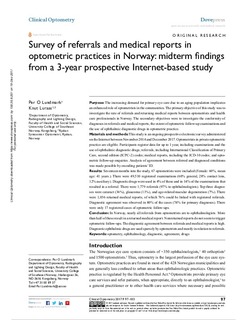| dc.description.abstract | Purpose: The increasing demand for primary eye care due to an aging population implicates an enhanced role of optometrists in the communities. The primary objective of this study was to investigate the rate of referrals and returning medical reports between optometrists and health care professionals in Norway. The secondary objectives were to investigate the conformity of diagnoses in referrals and medical reports, the extent of optometric follow-up examinations and the use of ophthalmic diagnostic drugs in optometric practice. Materials and methods: This study is an ongoing prospective electronic survey administered on the Internet between November 2014 and December 2017. Optometrists in private optometric practice are eligible. Participants register data for up to 1 year, including examinations and the use of ophthalmic diagnostic drugs; referrals, including International Classification of Primary Care, second edition (ICPC-2) codes; medical reports, including the ICD-10 codes; and optometric follow-up enquiries. Analysis of agreement between referred and diagnosed conditions was made possible by encoding patients’ ID. Results: Seventeen months into the study, 67 optometrists were included (Female: 60%, mean age: 41 years.). There were 49,510 registered examinations (60% general, 28% contact lens, 12% auxiliary). Diagnostic drugs were used in 4% of these and in 14% of the examinations that resulted in a referral. There were 1,779 referrals (97% to ophthalmologists). Top three diagnoses were cataract (36%), glaucoma (11%), and age-related macular degeneration (7%). There were 1,036 returned medical reports, of which 76% could be linked with registered referrals. Diagnostic agreement was observed in 80% of the cases (74% for primary diagnoses). There were only 17 registered cases of optometric follow-ups. Conclusion: In Norway, nearly all referrals from optometrists are to ophthalmologists. More than half of these result in a returned medical report. Nonreturned reports do not seem to trigger optometric follow-ups. The diagnostic agreement between referrals and medical reports is high. Diagnostic ophthalmic drugs are used sparsely by optometrists and mostly in relation to referrals. | nb_NO |

